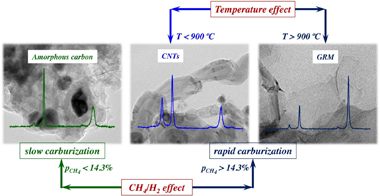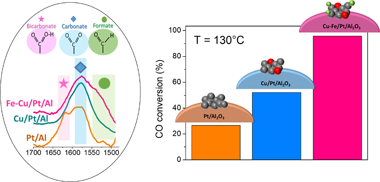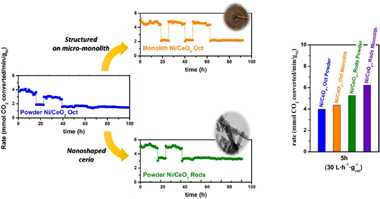Scientific Papers in SCI
2022
2022
Química de Superficies y Catálisis
Performance of AISI 316L-stainless steel foams towards the formation of graphene related nanomaterials by catalytic decomposition of methane at high temperature
Cazana, F; Latorre, N; Tarifa, P; Royo, CJ; Sebastian, V; Romeo, E; Centeno, MA; Monzon, ACatalysis Today, 383 (2022) 236-246
Show abstract ▽

This work explores the preparation of graphene-related materials (GRMs) grown on stainless steel foams via catalytic decomposition of methane (CDM). The main active phases for the reaction are the Fe nanoparticles segregated from the stainless-steel after the activation stage of the foam. The effect of the feed composition and reaction temperature has been studied in order to maximize the productivity, stability and selectivity to GRMs. The maximum productivity attained was 0.116 g(C)/g(foam) h operating at 950 degrees C with a feed ratio of CH4/H-2 = 3 (42.9 %CH4:14.3 %H-2). The carbonaceous nanomaterials (CNMs) obtained were characterized by X-Ray diffraction, Raman spectroscopy and by transmission and scanning electron microscopy. The parameters of the kinetic model developed are directly related to the relevant stages of the process, including carburization, diffusion-precipitation and deactivation-regeneration. The balance among these sequential stages determines the overall performance of the activated foam. In conditions of rapid carburization of the Fe NPs (p(CH4) > 14 %), the productivity to CNMs is favoured, avoiding an initial deactivation of the active sites by fouling with amorphous carbon. After a rapid carburization, the selectivity to the different CNMs is governed by the ratio CH4/H-2, and mainly by the temperature. Thus, the formation of GRMs, mainly Few Layer Graphene (FLG) and even graphene, is favoured at temperatures above 900 degrees C. At lower temperatures, carbon nanotubes are formed.
January, 2022 | DOI: 10.1016/j.cattod.2020.12.003
Química de Superficies y Catálisis
Unravelling the role of Fe in trimetallic Fe-Cu-Pt/Al2O3 catalysts for CO-PROX reaction
Palma, S; Gonzalez-Castano, M; Romero-Sarria, F; Odriozola, JAMolecular Catalysis, 517 (2022) 112015
Show abstract ▽

This work proposes a trimetallic Fe-Cu/Pt/Al2O3 catalyst as an appealing system for preferential oxidation of CO (CO-PROX) reaction. The excellent conversion rates achieved by the Fe-Cu/Pt/Al2O3 catalysts under realistic reforming-surrogated feed streams along with the catalyst stability, reproducibility, and scalability showcase a very competitive system for CO-PROX reaction units. Furthermore, the systematic analysis conducted for Pt/Al2O3, Cu/Pt Al2O3, and Fe-Cu/Pt/Al2O3 catalysts enabled establishing meaningful relationships between catalytic behaviour and the catalyst surface to reactants interactions. Thus, the enhanced CO oxidation performances attained by the incorporation of Fe species into bimetallic Cu/Pt/Al2O3 catalysts were associated to superior surface electron densities and inhibited CO adsorption process over Pt surfaces. Remarkably, operando-DRIFTS spectroscopy evidenced significantly larger H-containing surface species developed over the trimetallic system. The enhanced abilities for developing thermally instable intermediates favoured by small amounts of Fe should indeed determine the enhanced catalysts behaviours displayed by the trimetallic Fe-Cu/Pt/Al2O3 catalyst.
January, 2022 | DOI: 10.1016/j.mcat.2021.112015
Química de Superficies y Catálisis
Enhanced catalytic activity and stability of nanoshaped Ni/CeO2 for CO2 methanation in micro-monoliths
Garcia-Moncada, N; Navarro, JC; Odriozola, JA; Lefferts, L; Faria, JACatalysis Today, 383 (2022) 205-215
Show abstract ▽

Coupling inherently fluctuating renewable feedstocks to highly exothermic catalytic processes, such as CO2 methanation, is a major challenge as large thermal swings occurring during ON- and OFF- cycles can irreversible deactivate the catalyst via metal sintering and pore collapsing. Here, we report a highly stable and active Ni catalyst supported on CeO2 nanorods that can outperform the commercial CeO2 (octahedral) counterpart during CO2 methanation at variable reaction conditions in both powdered and mu-monolith configurations. The long-term stability tests were carried out in the kinetic regime, at the temperature of maximal rate (300 degrees C) using fluctuating gas hourly space velocities that varied between 6 and 30 L h- 1.gcat- 1. Detailed catalyst characterization by mu-XRF revealed that similar Ni loadings were achieved on nanorods and octahedral CeO2 (c.a. 2.7 and 3.3 wt. %, respectively). Notably, XRD, SEM, and HR-TEM-EDX analysis indicated that on CeO2 nanorods smaller NiClusters with a narrow particle size distribution were obtained (- 7 +/- 4 nm) when compared to octahedral CeO2 (- 16 +/- 13 nm). The fast deactivation observed on Ni loaded on commercial CeO2 (octahedral) was prevented by structuring the reactor bed on mu-monoliths and supporting the Ni catalyst on CeO2 nanorods. FeCrAlloy (R) sheets were used to manufacture a multichannel mu-monolith of 2 cm in length and 1.58 cm in diameter, with a cell density of 2004 cpsi. Detailed catalyst testing revealed that powdered and structured Ni/ CeO2 nanorods achieved the highest reaction rates, c.a. 5.5 and 6.2 mmol CO2 min- 1.gNi - 1 at 30 L h- 1.gcat- 1 and 300 degrees C, respectively, with negligible deactivation even after 90 h of fluctuating operation.
January, 2022 | DOI: 10.1016/j.cattod.2021.02.014
Nanotecnología en Superficies y Plasma - Tribología y Protección de Superficies
Compositional gradients at the nanoscale in substoichiometric thin films deposited by magnetron sputtering at oblique angles: A case study on SiOx thin films
Garcia-Valenzuela, A; Alcaide, AM; Rico, V; Ferrer, FJ; Alcala, G; Rojas, TC; Alvarez, R; González-Elipe, AR; Palmero, APlasma Processes and Polymers (2022) e2100116
Show abstract ▽
We demonstrate the existence of stoichiometric variations at the nanoscale when growing nanocolumnar SiOx thin films by reactive magnetron sputtering deposition at oblique angles. Results show stoichiometric variations in the range 0.3 < x < 1.3 when growing a SiO0.5 thin film. This agrees with results from a numerical growth model that obtains a shift of the stoichiometry in all nanocolumns from lower values at the side facing the Si target to higher values at the opposite side. The different momentum distribution of the gaseous reactive and sputtered species results in preferential incorporation of the latter at a particular side of the nanocolumns. The general occurrence of this mechanism during the reactive magnetron sputtering deposition of substoichiometric thin films at oblique angles is discussed.
January, 2022 | DOI: 10.1002/ppap.202100116
Materiales Ópticos Multifuncionales
Molecular Interface Engineering via Triazatruxene-Based Moieties/NiOx as Hole-Selective Bilayers in Perovskite Solar Cells for Reliability
Hemasiri, NH; Calio, L; Pegu, M; Kazim, S; Ahmad, SSolar RRL (2022) 2100793
Show abstract ▽
Interface engineering is an effective approach to decrease nonradiative recombination and the energy barrier at the perovskite/hole transporting layer (HTL) interfaces. To overcome such limitations, an organic semiconductor (DTT-EHDI2) is proposed, which is, composed of dithienothiophene (DTT) as the core and a planar triazatruxene incorporating an alkyl chain as the side group. This is noted to be an effective interfacial layer for inverted planar perovskite solar cells (PSCs). The altered interface effectively minimizes the detrimental charge recombination and tailors the photoinduced charge transfer dynamics at the interface of the inorganic HTL/perovskite. The pi-conjugation in DTT-EHDI2 induces high hole mobility and electrical conductivity via electron-donating properties and strong pi-pi intermolecular interaction. The synergetic approach leads to a substantial performance enhancement in dopant-free DTT-EHDI2-based inverted planar PSCs, achieving 18.15% power conversion efficiency with negligible hysteresis effect. The present approach provides an effective direction of the cost-effective thiophene derivative as an interfacial agent to escalate the optoelectronic performances in photovoltaics.
January, 2022 | DOI: 10.1002/solr.202100793
- ‹ previous
- 59 of 410
- next ›














